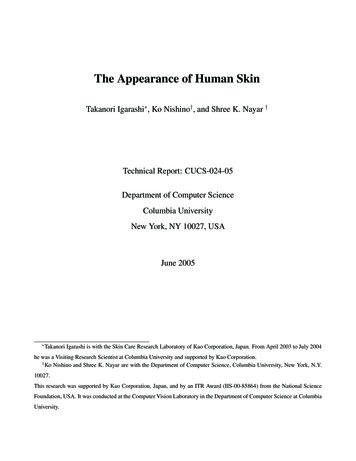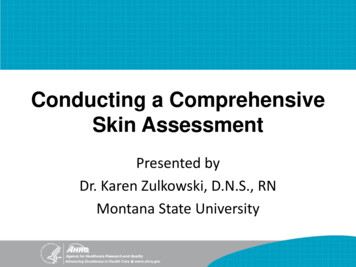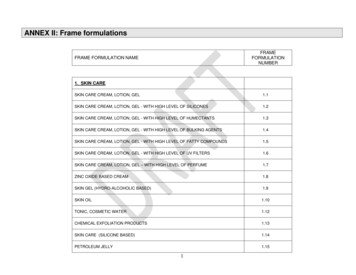
Transcription
The Appearance of Human SkinTakanori Igarashi , Ko Nishino† , and Shree K. Nayar †Technical Report: CUCS-024-05Department of Computer ScienceColumbia UniversityNew York, NY 10027, USAJune 2005 Takanori Igarashi is with the Skin Care Research Laboratory of Kao Corporation, Japan. From April 2003 to July 2004he was a Visiting Research Scientist at Columbia University and supported by Kao Corporation.†Ko Nishino and Shree K. Nayar are with the Department of Computer Science, Columbia University, New York, N.Y.10027.This research was supported by Kao Corporation, Japan, and by an ITR Award (IIS-00-85864) from the National ScienceFoundation, USA. It was conducted at the Computer Vision Laboratory in the Department of Computer Science at ColumbiaUniversity.
Contents1 Why is Skin Appearance Important?12 What is Skin?33 Taxonomy of Human Skin Appearance53.1Micro Scale . . . . . . . . . . . . . . . . . . . . . . . . . . . . . . . . . . . . . . . . .53.2Meso Scale . . . . . . . . . . . . . . . . . . . . . . . . . . . . . . . . . . . . . . . . .73.3Macro Scale . . . . . . . . . . . . . . . . . . . . . . . . . . . . . . . . . . . . . . . . .84 Physiology and Anatomy of Human Skin4.14.24.34.44.58Level 1: Cellular Level Elements . . . . . . . . . . . . . . . . . . . . . . . . . . . . . .94.1.1Cells . . . . . . . . . . . . . . . . . . . . . . . . . . . . . . . . . . . . . . . .94.1.2Fibers . . . . . . . . . . . . . . . . . . . . . . . . . . . . . . . . . . . . . . . . 114.1.3Chromophores . . . . . . . . . . . . . . . . . . . . . . . . . . . . . . . . . . . 13Level 2: Skin Layers . . . . . . . . . . . . . . . . . . . . . . . . . . . . . . . . . . . . 134.2.1Epidermis . . . . . . . . . . . . . . . . . . . . . . . . . . . . . . . . . . . . . . 144.2.2Dermis . . . . . . . . . . . . . . . . . . . . . . . . . . . . . . . . . . . . . . . 154.2.3Subcutis . . . . . . . . . . . . . . . . . . . . . . . . . . . . . . . . . . . . . . . 16Level 3: Skin . . . . . . . . . . . . . . . . . . . . . . . . . . . . . . . . . . . . . . . . 164.3.1Skin Layers . . . . . . . . . . . . . . . . . . . . . . . . . . . . . . . . . . . . . 164.3.2Hairs . . . . . . . . . . . . . . . . . . . . . . . . . . . . . . . . . . . . . . . . 174.3.3Skin Surface Lipid . . . . . . . . . . . . . . . . . . . . . . . . . . . . . . . . . 184.3.4Fine Wrinkle . . . . . . . . . . . . . . . . . . . . . . . . . . . . . . . . . . . . 18Level 4: Skin Features . . . . . . . . . . . . . . . . . . . . . . . . . . . . . . . . . . . 194.4.1Wrinkle . . . . . . . . . . . . . . . . . . . . . . . . . . . . . . . . . . . . . . . 204.4.2Pore . . . . . . . . . . . . . . . . . . . . . . . . . . . . . . . . . . . . . . . . . 214.4.3Freckle, Spot, and Mole . . . . . . . . . . . . . . . . . . . . . . . . . . . . . . 22Level 5: Body Regions . . . . . . . . . . . . . . . . . . . . . . . . . . . . . . . . . . . 23i
5 Models for Human Skin Appearance5.15.25.325Cellular Optics . . . . . . . . . . . . . . . . . . . . . . . . . . . . . . . . . . . . . . . 265.1.1Absorption of Cellular Level Elements . . . . . . . . . . . . . . . . . . . . . . 275.1.2Scattering from Cellular Level Elements . . . . . . . . . . . . . . . . . . . . . . 28Cutaneous Optics . . . . . . . . . . . . . . . . . . . . . . . . . . . . . . . . . . . . . . 305.2.1Optical Pathways in Skin . . . . . . . . . . . . . . . . . . . . . . . . . . . . . . 305.2.2Optical Parameters for Scattering and Absorption . . . . . . . . . . . . . . . . . 325.2.3Models for Light Transport in Skin . . . . . . . . . . . . . . . . . . . . . . . . 38BRDF and BSSRDF . . . . . . . . . . . . . . . . . . . . . . . . . . . . . . . . . . . . 445.3.1BRDF . . . . . . . . . . . . . . . . . . . . . . . . . . . . . . . . . . . . . . . . 445.3.2BSSRDF . . . . . . . . . . . . . . . . . . . . . . . . . . . . . . . . . . . . . . 525.4BTF . . . . . . . . . . . . . . . . . . . . . . . . . . . . . . . . . . . . . . . . . . . . . 595.5Appearance of Body Regions and Body Parts . . . . . . . . . . . . . . . . . . . . . . . 626 Summary66ii
1 Why is Skin Appearance Important?Skin is the outermost tissue of the human body. As a result, people are very aware of, and very sensitiveto, the appearance of their skin. Consequently, skin appearance has been a subject of great interest inseveral fields of science and technology. As shown in Figure 1, research on skin appearance has beenintensely pursued in the fields of medicine, cosmetology, computer graphics and computer vision. Sincethe goals of these fields are very different, each field has tended to focus on specific aspects of theappearance of skin. The goal of this study is to present a comprehensive survey that includes the mostprominent results related to skin in these different fields and show how these seemingly disconnectedstudies are closely related.In the field of computer graphics, computational modeling of the appearance of skin is today considered to be a very important topic. Such skin appearance models are widely used to render fictionalhuman characters in movies, commercials and video games. For these “virtual actors” to appear realisticand be seamlessly integrated into a scene, it is crucial that their skin appearance accurately capturesComputer VisionComputer GraphicsPhotorealistic RenderingFace RecognitionAnimationPeople TrackingGeometric Modeling.Fingerprint Identification.Skin AppearanceDisease DiagnosisMakeup DevelopmentPhototherapyCosmetic SurgeryDrug Development.Skin Care Counseling.CosmetologyMedicineFigure 1: Many different research fields have conducted extensive research on the appearance of skin.The fields of medicine, cosmetology, computer graphics and computer vision have been most active inthe study of skin appearance. Studies in each of these fields provide us knowledge and insights regardingdifferent aspects of skin appearance.1
all the subtleties of actual human skin under various viewing and lighting conditions. Although greatprogress has been made in making rendered skin appear realistic, it is still far from perfect and is easilyrecognized as being rendered rather than real. In short, a computationally efficient and yet realistic skinmodel remains an open problem in computer graphics.In computer vision, a detailed and accurate model of skin appearance is of great value in identifyingindividuals. For instance, human identification based on fingerprints has made substantial progress andis now a widely used biometric technology. It is now widely acknowledged that accurate models ofthe appearance of skin in other parts of the body could be useful for human identification as well. Forinstance, technologies that recognize the pattern of blood vessels in the palm and the finger have been recently developed and have shown good performance in identification. In order to reliably exploit similarsignatures of skin appearance from other body regions, we need a more comprehensive understandingof the visual characteristics of skin.Skin also has aesthetic relevance. The desire to have beautiful and healthy looking skin has beena centuries-old quest for humans. Skin with brighter complexion and smoother surface tends to beperceived as being healthier and more attractive. Making skin appear beautiful is the primary goal ofcosmetology. For instance, foundations are widely used to hide skin imperfections and make skin lookyounger. Despite the enormous investments made in skin research, today’s foundations are far fromperfect. While they may hide imperfections and make skin appear more uniform, the final appearance ofskin coated with a foundation always has an artificial look to it. Recently, skin counseling systems havebeen developed to help a person identify cosmetic products that would be most suited to them. Suchsystems can also benefit from more accurate and detailed models of skin appearance.Needless to say, the appearance of skin is of vital importance to the field of medicine. During thediagnosis of skin diseases, careful observation and assessment of the appearance of the diseased areais always the first and most important step. Recently, photo-diagnosis and photo-therapy have becomepopular methods for treating skin diseases. In these techniques, light is used to detect and treat lesions inthe skin. Such techniques are non-invasive and hence patients are not subjected to pain and scars duringthe treatment. In order to increase the precision of such systems, we need more precise models of theinteraction of light with dermal tissues.In this survey, we will summarize and relate studies on skin appearance conducted in the above fields.Our goal is to present the disconnected works in these different areas within a single unified framework.2
In each of the above fields, the optical behaviors of specific skin components have been studied from theviewpoint of the specific objectives of the field. However, the different components of skin produce different types of optical phenomena that are determined by their physio-anatomical characteristics (sizes,shapes and functions of the components). The final appearance of skin has contributions from complexoptical interactions of many different skin components with light. In order to view these interactions ina unified manner, it is meaningful to describe and categorize past works based on the physiological andanatomical characteristics of the various skin components. To this end, we will first outline the physioanatomical characteristics of skin that are important to its appearance. Then, we will review previousstudies that have been conducted on each of the structural components of skin.We will start our survey by describing the basic functions of human skin in Section 2. This knowledgeis necessary to understand the physio-anatomical properties of the components of skin. In Section 3, wewill propose a taxonomy of skin appearance that serves as the basic structure of our survey. In this taxonomy, we summarize the important physio-anatomical components of skin and the optical phenomenathey produce. In Section 4, we will describe in detail the physio-anatomical structure and character ofeach skin component. In Section 5, we will review studies on skin appearance that have been conductedin the four fields shown in Figure 1. We hope our survey will have two effects. The first is to broadenand deepen the reader’s understanding of skin appearance. The second is to spur new interdisciplinaryresearch on skin appearance.2 What is Skin?Skin is the outermost tissue of the body and the largest organ in terms of both weight and surface area.It has an area of approximately 16, 000 cm2 for an adult and represents about 8% of the body weight.As seen in Figure 2, skin has a very complex structure that consists of many components. Cells, fibersand other components make up several different layers that give skin a multi-layered structure. Veins,capillaries and nerves form vast networks inside this structure. In addition, hairs stick out from the insideof skin. Numerous fine hair furrows are scattered over the surface of skin.Skin performs a wide variety of functions resulting from chemical and physical reactions inside thesecomponents. The major function of skin is to act as a barrier to the exterior environment. It protects thebody from friction and impact wounds with its flexibility and toughness. Harmful chemicals, bacteria,3
Figure 2: A cross-sectional schematic diagram of skin. Skin is a complex multi-layered tissue consistingof various types of components, including veins, capillaries, hairs, cells, fibers, etc. (Image courtesy ofA.D.A.M.)viruses and ultraviolet light are also prevented from entering the body by the skin. It also prevents waterloss and regulates body temperature by blood flow and evaporation of sweat. These functionalities arecritical to our well being. The secretion of sweat and skin lipid cause the elimination of a number ofharmful substances resulting from metabolic activities in the intestines and the liver. Furthermore, skinhas a large amount of nerve fibers and nerve endings that enable it to act as a sensory organ. When skinis exposed to sunlight, it can produce vitamin D, an imperative chemical substance for the body [139].These functions of skin tend to vary in degrees according to age, race, gender and individual. Forinstance, older skin tends to lose its flexibility and toughness because the structure of skin slowly denatures with age. Negroid or Mongoloid skin have higher light-protection ability than Caucasian skinbecause of the differences in the volume of melanin, which absorbs ultraviolet light. These functionaldifferences are in most cases a result of physio-anatomical variations within the structure of skin. It isthese physio-anatomical variations that lead to the diverse appearances of skin. Hence, in order to understand the appearance of skin, it is crucial to understand the physiology and anatomy of skin. In the nextsection, we will present a taxonomy of skin appearance that is based on physiology and anatomy. Then,4
in Section 4, we will use this taxonomy to describe the physio-anatomical properties of the various skincomponents.3 Taxonomy of Human Skin AppearanceIn order to understand the appearance of skin, it is important to understand the optical/visual propertiesof the constituent components of skin. In this section, we present a hierarchical representation of skincomponents that is based on the scale of the optical processes induced by the components.As shown in Figure 3, the components of skin appearance can be categorized along an axis thatrepresents spatial scale. Here, we only focus on skin components that have a measurable contributionto its appearance. We refer to the smallest components as micro scale, larger components as mesoscale and the largest components as macro scale. Each scale is subdivided into finer levels based onphysiology and anatomy. As a result, skin can be viewed as a hierarchical organ in which componentsat one level serve as building blocks to constitute higher-level components. The components in eachlevel have their own visual properties. Each of these visual properties is studied based on its underlyingphysical phenomena. The scattering or appearance model that describes these phenomena are listed inthe rightmost column in Figure 3.3.1 Micro ScaleCellular level elements and skin layers constitute the finest scale of the physio-anatomical structureof skin. The sizes of these components are very small and they are barely visible to the naked eye.The visual properties of these elements are the result of their optical interactions with incident light.From an optical viewpoint, the dominant effects produced at this scale are scattering and absorption.These effects vary depending on the sizes, shapes and optical parameters such as the refractive indicesof the elements. For example, fibers and organelles that are found in cells behave as strong scatterers.The cell membranes and the blood vessel walls behave like reflectors and refractors, respectively. Theaggregation of these optical phenomena determine the visual properties of the components at higherlevels. Some of these elements, such as organelles, have sizes close to the wavelength of visible light.Hence, the optical properties at this level must be studied using wave optics.The cellular level elements constitute several primary layers of skin: epidermis, dermis and subcutis,5
Figure 3: Taxonomy of the appearance of skin. The components of skin appearance can be hierarchicallycategorized along an axis that represents physical scale. We review the studies on skin appearance donein different fields based on this taxonomy.6
which are classified in Level 2 in Figure 3. These layers have very different structures and constituentsand hence their physiological characteristics are different from each other. For example, the epidermisis a very thin layer (0.2 mm on average) which mainly consists of cells. On the other hand, the dermisis a thick layer (2 mm on average) composed of more fibers compared to the epidermis. These physioanatomical differences have large influences on the light propagation in these layers and lead to verydifferent optical effects. For example, the epidermis is a transparent optical medium and the dermis is aturbid medium. These optical differences enable us to view these layers as the primary optical media fordescribing the optical properties of higher scale components.3.2 Meso ScaleSkin and skin features constitute the meso scale. At this scale, the components become visible to thenaked eye. The visual properties of these components are mainly determined by the optical phenomenathat are induced by finer scale components – components in the micro scale.Skin, as categorized in Level 3 in Figure 3, is composed of skin layers, skin surface lipid, hairs, finewrinkles, etc. The appearance of skin can be viewed as the combined effect of the optical phenomenainduced by these substructures. Skin layers include the lower level components in Level 2 – epidermis,dermis and subcutis. Visual property of skin layers can also be considered as the combined effect of theoptical events that take place in each of these layers. Hence, understanding the optical properties in themicro scale is required to understand the visual properties of the components in the meso scale.Skin surface lipids, hairs and fine wrinkles are found on the surface of skin. They contribute interestingoptical effects. For example, the appearance of skin after sweating usually becomes more glossy. Thischange of appearance is mainly due to the reflection of incident light by the film of skin surface lipids.The appearance of skin with dense hair and fine wrinkles tends to be more matte. This is because of theadditional scattering of incident light by the hairs and fine wrinkles.Skin constitutes higher level components – skin features such as freckles, moles, wrinkles and pores(see Level 4 in Figure 3). These features can be viewed as morphological variations of skin. For example, freckles and moles tend to produce two-dimensional variation in skin color. In contrast, wrinklescause deep furrows and flat planes and are inherently three-dimensional textures. Hence, the visualproperties of skin features are influenced by not only the optical properties of the skin layers but also the7
morphology of skin.3.3 Macro ScaleBody regions and body parts are classified as macro scale and physiologically assigned to Level 5 andLevel 6, respectively (see Figure 3). The appearance of skin varies across different regions of the body.This is because the physio-anatomical characteristics of the lower-level components can differ significantly from one region of the body to another. For example, the nose and the forehead have greateramounts of skin surface lipid compared to the cheek. As a result, the nose and the forehead tend toappear more glossy than the cheek. To our knowledge, there are no physical models that describe theseappearance variations over the body in a unified framework. Body parts such as the face, arm, legand torso are clusters of body regions. The appearance of each body part includes the appearances ofthe body regions that constitute it. Again, we are not aware of any physical or empirical models fordescribing part appearances.It is interesting to note that the four fields that have been involved in skin research have tended to focuson different scales or levels of skin appearance. In computer graphics and computer vision, componentsin the visible scale have been studied. This is because the main objectives in these fields are to renderand recognize skin appearance. Thus, previous work in graphics and vision provide us with knowledgeabout the visual properties of skin mainly at the meso and macro scales. On the other hand, researchin medicine has focused on smaller scale elements. This is because skin diseases are usually caused bydisorders in the micro scale components. Thus, past work in medicine provides us with knowledge aboutthe optical properties of skin at the micro scale. By reviewing work in these different fields, we can spanall the scales of skin appearance and, at the same time, describe all of the previous works in a consistentmanner.4 Physiology and Anatomy of Human SkinThe optical and visual properties of skin components at each level of our taxonomy (Figure 3) differsignificantly depending on their physio-anatomical characteristics. For example, light scattering behaviors of cells and fibers (Level 1) depend on their sizes and shapes. Light propagation in the skin layers,i.e. the epidermis and the dermis (Level 2), are very different since their structures, densities and thick8
nesses vary greatly. Reflection at the surface of skin is influenced by the morphological characteristicsof fine wrinkles (Level 3). The appearance of wrinkles themselves also depend on their morphologicalcharacteristics such as depth, width and density variations. Most of these optical and visual propertiesare different for different body regions (Level 5) and body parts (Level 6) since the physio-anatomicalcharacteristics of the lower-level components (Levels 1 to 4) vary across the body. The above examplesare used to convey the importance of understanding the physio-anatomical properties of each of the skincomponents.4.1 Level 1: Cellular Level ElementsAlthough skin is composed of various types of cellular level elements, cells, fibers and chromophores areof special relevance to us. This is because light scattering and absorption in these fundamental elementsare the building blocks of the gross optical phenomena observed at the cellular level.4.1.1 CellsSkin includes various types of cells. The main cells are keratinocyte, fibroblast, fat cell, melanocyte anderythrocyte. These cells are present in different locations and have different structures and functions.Keratinocytes are quantitatively the dominant constituent cells in the epidermis. These cells producefibriform proteins called keratin which contribute to the rigidity of the outermost layer of skin. Kerationocytes protect the body from the external environment, for instance from stimulation, friction andviruses, while retaining moisture. Keratinocytes can be further categorized into four types of cells basedon their functions and structures: basal cells, prickle cells, granular cells and horny cells. Althoughthese cells have the same origin, they have different shapes, functions and subcellular level elementscalled organelles. For example, the basal cell, which reproduces keratinocytes, is a cylindrical and softliving cell. On the other hand, the horny cell, which mainly acts as a protector from the external environment, is a very flat and hard dead cell in which most organelles are degenerate.Fibroblasts are long and narrow cells present in the dermis, the second skin layer beneath the epidermis.They produce collagen and elastin fibers which are the primary constituents of the dermis.Fat cells are quantitatively the most abundant cells of the dermis. These cells accumulate fat and theirsizes vary according to the volume of fat contained in them. These cells do not absorb much light. On9
Figure 4: Scanning electron microscope image of erythrocytes. Erythrocytes contain one of the mainlight-absorbing chemical compounds in skin, hemoglobin. (Courtesy of A.M. Cohen, Tel-Aviv University.)the other hand, melanocyte and erythrocyte cells, both of which contain chromophores, mainly absorblight.Melanocytes carry melanin which is one of the main light-absorbing pigments in skin. There are generally 1000 to 2000 melanocytes in 1 mm2 of skin. This cell contains specialized organelles calledmelanosomes. When skin is exposed to sunlight, melanosomes are activated and produce melanin. Thedensity of melanosomes depends on the body region. For example, regions that are frequently exposedto sunlight, such as the face, have higher density than other regions.Erythrocytes (or red blood cells) are the carriers of hemoglobin, another light-absorbing pigment inskin. As seen from Figure 4, erythrocytes have biconcave structures. The diameter of an erythrocyte isapproximately 5 µm [2]. Erythrocytes usually contain more than 300 mg/mL of hemoglobin and carryoxygen from the lungs to tissues and carbon dioxide from tissues to the lungs.As shown in Figure 5, a typical cell is composed of a cell membrane and organelles such as nucleus,mitochondria, lysosome, cytoplasm, Goldi apparatus, endoplasmic reticulum, etc. The nucleus, whichis the largest spherical organelle, ranges from 3 to 10 µm in size and is enclosed in a membrane calledthe nuclear envelope. The nucleus includes most of the DNA of a cell and serves as the storage areafor genetic information. The mitochondria is 0.5 to 1.5 µm in size and is an oval-shaped organellecomposed of a double membrane. The mitochondria generates energy from food. The cell membraneis the outermost layer of a cell and has a doubly-layered structure of lipids (bilayer membrane). Thethickness of the cell membrane is approximately 15 nm [46].10
Nuclear envelopeCytoplasmNucleousChromatin}NuclearCell olgi apparatusFigure 5: A schematic representation of a cell. The cell usually contains many types of organelles. Insome types of cells, such as the horny cell, these organelles are denatured. (Image courtesy of A.D.A.M.)4.1.2 FibersSkin contains several types of fibers. We will consider keratin, collagen and elastin as typical types offibers found in skin.Keratin fibers are mainly found in the outer-level epidermal cells, including horny cells. These fibersprotect the inner side of skin from the external environment. At the same time, they contribute tomoisture-retention in skin by holding water. The length and diameter of these fibers depend on theamount of moisture they actually hold.Collagen fibers are the main constituents of the dermis. They represent about 70% of the dermis indry weight. These fibers form vast and tough networks providing the dermis with strength, tension andelasticity. As shown in Figure 6, a collagen fiber is 0.5 to 3 µm in diameter [2] and has a very long shape.A collagen fiber has a hierarchical structure [2] and is essentially a bundle of smaller microcables calledcollagen fibrils. Collagen fibrils are 10 to 300 nm in diameter and many micrometers long. A collagenfibril is a bundle of triple stranded collagen molecules (about 1.5 nm in diameter [2, 106] and 300 nmlong [106]), three polypeptide chains that are wrapped around each other as a triple helix.The structure of collagen fibers starts to denature around the age of thirty. Photo-damaging, whichoccurs with ultraviolet light in sunlight and due to smoking, also denature the structure of collagen fibers.These factors eventually cause morphological changes to the network of collagen fibers. This leads toloss of skin elasticity and finally induces wrinkling [17, 1, 160, 27, 97].Elastin fibers are random coiled proteins that are also present in the dermis. These fibers are thinner11
1µmcollagen fibers0.5 - 3µmcollagenfibril10 - 300µmtriple-strandedcollagen molecule1.5nmsingle collagenpolypeptide chainFigure 6: The structure of collagen fibers. Collagen fibers are composed of collagen fibrils that arebundles of collagen molecules made of polypeptide chains. (From B. Alberts, D. Bray, A. Johnson,cJ. Lewis, M. Raff, K. Roberts and P. Walter, Essential Cell Biology, 1998, 1998Garland SciencePublishing, Reprinted with permission [2].)than collagen bundles (1 to 3 µm in diameter [106]). They occupy 2 to 4% of the total weight of thedermis. An elastin fiber consists of two components – micro-fibrils and matrix elastin. The micro-fibrilsare aggregated at the periphery of elastic fiber (10 to 12 nm thick) and are also present within elastinfibers as strands aligned along the longitudinal direction (15 to 80 nm thick) [106].Elastin fibers provide skin with elasticity and resilience. Even though the volume of elastin fibers ismuch smaller than that of collagen fibers, elastin fibers also play an important role in providing structuralsupport to the dermis. Similar to collagen fibers, aging and ultraviolet light degrade elastin fibers, whichfinally leads to wrinkling. Elastin fibers are extensible and return to their original shapes after stretching.This property is not found in collagen fibers [106].12
4.1.3 ChromophoresSkin includes various types of light-absorbing chemical compounds called chromophores. Among thesechromophores, melanin and hemoglobin are especially important for understanding the appearance ofnormal skin since they absorb light particularly in the visible wavelength range [6, 187].Melanin is the dominant chromophore of the epidermis. It can also be found in hair. Melanin is firstproduced in melanosomes, then is diffused into the epidermal layer, and moves up towards the surfaceof skin while denaturing. Through this upward process, melanin changes its color from tan to white.Melanin is divided into two types, eumelanin and pheomelanin, depending on its chemical structure.Eumelanin is a black or dark brown chromophore usually found in dark hair and eyes. Pheomelanin isyellow or reddish brown chromophore that is observed in red hair and feathers. Usually, normal skincontains some amount of eumelanin. Therefore, in most studies on skin, “melanin” is referred to as“eumelanin” [78].The physiological function of melanin is to protect the inside of skin by absorbing and scatteringultraviolet light. When exposed to sunlight, melanocytes start to produce melanin. This is the biologicalreaction that eventually makes our skin appear tanned.The color of skin depends on the fraction of the volume of the melanosomes. In the light coloredskin of Caucasians, the fraction is only between 1 and 3%. In the skins of well-tanned Caucasians andMediterraneans, the p
The Appearance of Human Skin Takanori Igarashi , Ko Nishino†, and Shree K. Nayar † Technical Report: CUCS-024-05 Department of Computer Science Columbia University New York, NY 10027, USA June 2005 Takanori Igarashi is with the Skin Care Research Laborator










